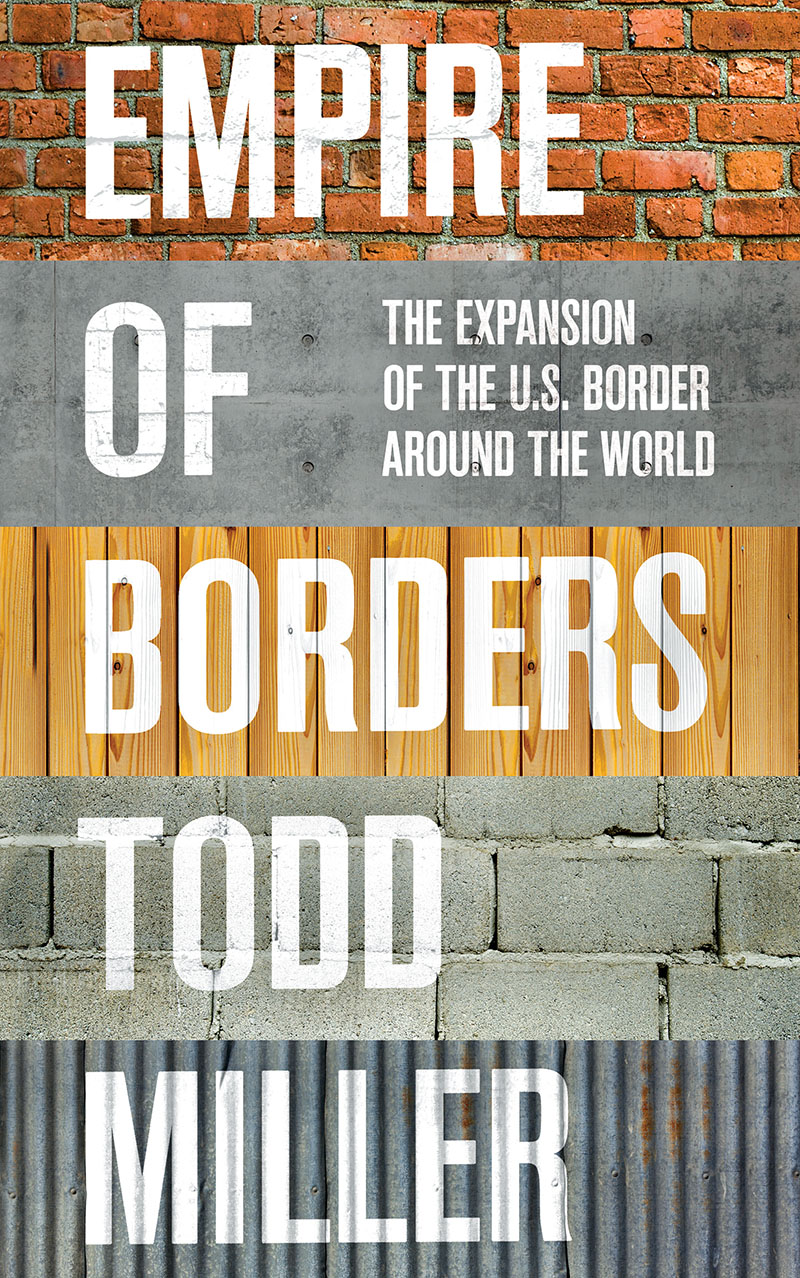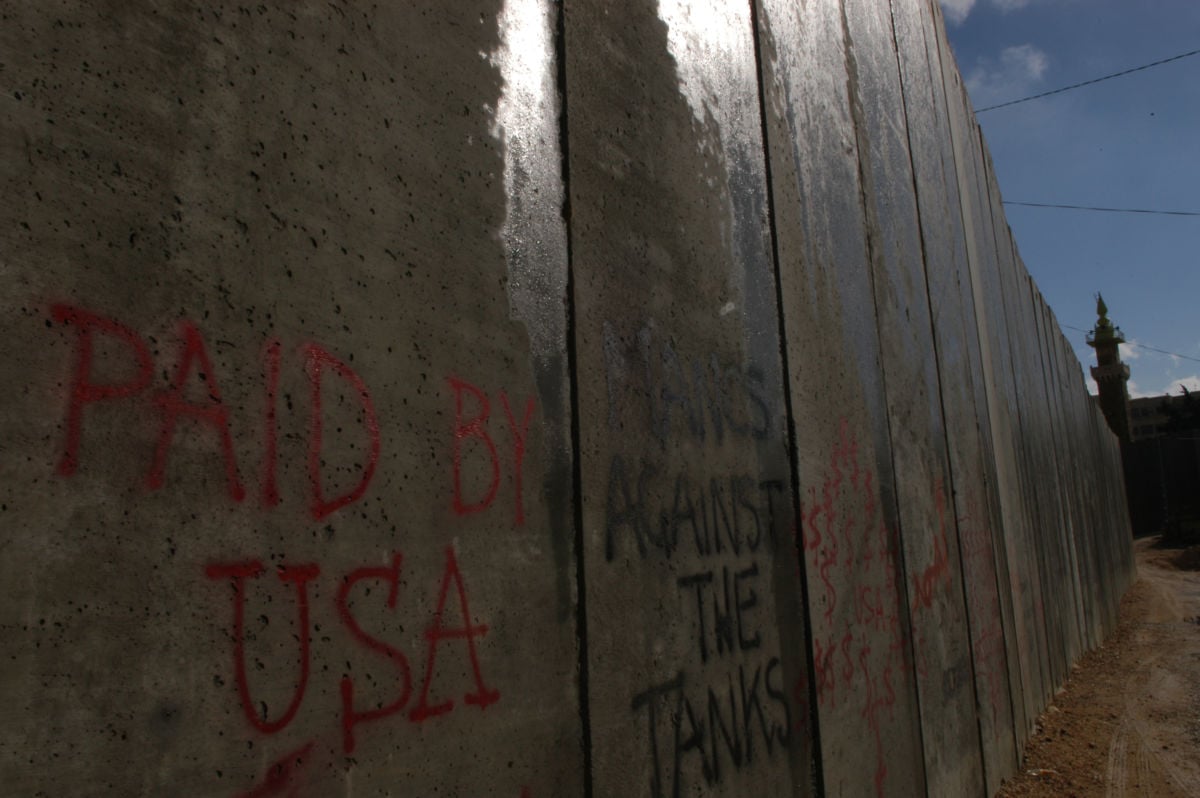Part of the Series
Progressive Picks
At a border technology conference in El Paso, Texas, in 2012, I asked a representative of the Israeli company RT Aerostat Systems whether the surveillance blimp hanging in the rafters of the expo hall could see the words I had scrawled in my notebook. Using the airborne cameras, the vendor zoomed in. Slowly but surely, my handwriting went from blurry to crystal clear on the large monitor for all to see. As in Tel Aviv, I was surrounded by vendors hawking everything from drones to desert-camouflaged armored vehicles, including one from Lockheed Martin that looked so dystopian I could barely take my eyes off it, a Mad Max scene, a future that nobody really wanted but everybody was being prepared for. Just five blocks away, the U.S. Border Patrol was policing one of the sharpest lines of division, in terms of inequality, on the face of the earth.
That same day, Israeli Brig. Gen. Roie Elkabetz stood in front of an audience of private-sector businesspeople, uniformed U.S. Border Patrol and other DHS officials, and border-patrol members from other countries, including a man from the Brazilian military dressed in full regalia. As Elkabetz lectured on how Israel did border enforcement, he clicked through a slide show of all of Israel’s frontiers: with Egypt, Jordan, Lebanon, Syria, and, of course, the Palestinian occupied territories. Finally, a photo of the enclosure wall that isolated the Gaza Strip from Israel flashed onscreen.
“We have learned lots from Gaza,” he said. “It’s a great laboratory.” At the time I was shocked that the general had used the word laboratory so casually, pausing only briefly before continuing to the next point. Later, I would learn that laboratory was part of the common parlance. I had heard the term used to describe the U.S.- Mexico border as well, as if migrants in those borderlands and people in Palestine were not only threats but also specimens under a large security microscope. The idea of synergy between the two “laboratories” was not so farfetched, especially considering the long-standing “special” relationship between the two countries and the lavish funds that the United States has poured into Israel over the years. Stephen Graham, author of Cities Under Siege: the New Urban Militarism, has written that the security-industrial and military-industrial complexes of Israel and the United States were so “umbilically connected” that “it might now be reasonable to consider them as a single diversified, transnational entity.”

Indeed, one year after the creation of Israel in 1948, the new state received its first U.S. aid: a $100 million export-import loan. It would take another ten years for the United States to grant Israel its first large-scale military loan — $400,000 in 1958 — but after that, the faucet stayed open. Only one year after former President Dwight D. Eisenhower’s famous farewell speech in 1961 decrying the military- industrial complex, Israel purchased its first advanced-weapons systems from the United States, Hawk anti-aircraft missiles. In 1966 alone — the year before the Six-Day War, in which Israel would seize the West Bank from Jordan (including East Jerusalem), the Golan Heights from Syria, and the Gaza Strip from Egypt — U.S. assistance more than doubled, from $37 million to $90 million. Much of Israel’s border building around and inside today’s Palestinian occupied territories originated from this historic moment in 1967, and since then it has always been backed by incrementally growing U.S. military and economic aid. By the end of the 1980s, the United States was doling out almost $2 billion annually in military aid to Israel, and in 1999 began sending a series of ten-year military aid packages (at that time worth approximately $2.38 billion annually). Just a few weeks before I trudged through the Qalandiya checkpoint in September 2016, the Obama administration approved the third such ten-year agreement, amounting to $38 billion to be sent between 2016 and 2026, ensuring the small country would continue to be, by far, the largest recipient of U.S. military — and now, homeland security — aid. In total, since 1948, the United States has provided Israel $134 billion in bilateral assistance, out of which $95 billion has been military equipment and arms.
Unlike other recipients of U.S. military largesse, Israel has been able to invest 25 percent of the money directly in its own private industry. (All other U.S. military aid packages require that countries use vouchers to buy their “assistance” from the United States and its industries.) In January 2015, with a couple of other journalists, I climbed a steep hill on a dirt road in the Coronado National Forest, about ten miles to the north of Nogales, Arizona. From below I could see the scaffolding of a new surveillance tower the Haifa-based company Elbit Systems was building. As I walked, I could see a smattering of people above: a construction crew. When we reached the top of the hill, a burly man wearing a combat helmet and a T-shirt that said “International Towers” met us before we could proceed any farther. He had a gun strapped to his side; the border guard of the border infrastructure. It looked as if the long-term U.S. investment in the Israeli “laboratory” was bearing significant fruit. In 2014, Elbit Systems of America received the much-sought-after and potentially billion-dollar Integrated Fixed Tower contract. Now here the firm was in southern Arizona, building 53 towers equipped with cutting-edge surveillance technology: highly sophisticated cameras that could see seven miles away, even at night, sensing the heat generated by living creatures; ground-sweeping radar systems that also fed into command and control rooms where bleary-eyed agents stared into monitors; thousands of implanted motion sensors that if “tripped” would beep in the same control rooms; and a GPS system able to home in on the exact coordinates of any border transgression. Jacob Stukenberg, a Border Patrol agent I talked to in a July 2018 interview, told me enthusiastically that the Integrated Fixed Tower was a “force multiplier” and that it could do the work of “100 agents.” In the West Bank, Elbit had been one of the primary technology contractors for the “smart wall,” which included sensors and cameras embedded into the wall itself, underground sensors, and drones patrolling the skies above. In its bid for the U.S. contract, Elbit touted its “ten-plus years’ experience securing the world’s most challenging border” as a selling point. Much of Elbit’s growing revenue — $3.4 billion reported in 2017, 3.6 percent higher than 2016 — is a result of increased sales in the border surveillance — homeland security market.
Particularly since 9/11, there has been considerable participation of Israeli companies in U.S. border enforcement. The first surveillance UAVs to do flyovers at the U.S. borderlands were Hermes drones made by Elbit Systems in 2004. (The same drones have been extensively used in the occupied territories, especially Gaza.) And NICE Systems, a company founded by seven ex-IDF soldiers, got a contract from the infamous Joe Arpaio, then sheriff of Arizona’s Maricopa County, to provide one of his prisons with closed-circuit television cameras. The Golan Group, also made up of former IDF soldiers, trained U.S. Homeland Security officials in 2008 in Krav Maga, an Israeli martial art characterized by close-contact hand-to-hand combat. They taught Immigration and Customs Enforcement (ICE) agents the importance of seeing “the whites of the enemies’ eyes.” This was during a time of massive expansion of the U.S. Homeland Security apparatus, particularly of its Border Patrol ranks. Between 2006 and 2008, the department hired 6,000 new agents. From 1994 to approximately 2014, the U.S. Border Patrol quintupled from 4,000 to almost 21,000 agents. Throughout this expansion, which included orienting police forces toward more securocratic combat, Israel has trained U.S. Customs and Border Protection, Homeland Security officials, and thousands of U.S. law enforcement officers in counter- terrorism and border and perimeter security. One such program, the Law Enforcement Exchange Program (LEEP) claimed that more than 11,000 U.S. police agents have attended their training courses and conferences. One of those trainees was Gil Kerlikowske, before he became Customs and Border Protection commissioner during the last years of the Obama administration. When he went to Israel, he was chief of the Seattle Police Department. Referring to the importance of corporate participation in law enforcement, he told LEEP what he learned, “I think I need to do a much better job of embracing private industry and going after them, not waiting for them to knock on my door.”
The Israeli-U.S. border relationship has continued to be strong. On January 27, 2017, when the Trump administration doubled down on its campaign promise to build a border wall on the U.S. southern divide, Israel’s Magal Security Systems, which claimed that it could build the exact wall desired, saw its stock jump 5.6 percent. And in September 2017, DHS chose the Israeli firm Elta North America to build one of the border wall prototypes, to name just a couple of examples.
As Jeff Halper argues, it is not just Israeli technology but also a “security state,” an apparatus of practices and policies that is proliferating around the world. War has been reframed, the police have become more militarized; the military has been “policified.” While law enforcement agents carry AR-15s and work in zones of exception, like border patrols, soldiers are taking on law enforcement duties; the National Guard polices the border. Halper calls this the MISSILE complex, an acronym for military, internal security, intelligence, and law enforcement. The divisions of the police and military of the nation-state are breaking down and reforming to create an even more powerful force: the crux of homeland security. Israel has modeled a system of control in a world characterized by increasing displacement and upheaval, the “Global Palestine.”
To express this concept specifically for the U.S.-Mexico divide, journalist Jimmy Johnson coined the phrase “Palestine-Mexico border.” Brig. Gen. Elkabetz is one of many people involved in the Israeli border and homeland security apparatus who have spoken to U.S. officials and the corporate nexus. In 2018, I saw an official from Elbit Systems — a former battalion and brigadier commander in the IDF — speak about Israel’s border successes (the rules of the forum do not allow me to use his name). Comparing the U.S. and Israeli borders, he said, “We have a lot of similarities, but there are differences.” As the former commander talked, he laid down the threats as one lays down bricks, building an edifice that stressed terrorism. When asked about the effectiveness of walls, he answered that it was important that walls work in tandem with technology and personnel. He explained just how effective the Israeli system was. He said that in 2014 Israel saw 40,000 immigrants from Sudan, mainly asylum-seekers, come over its Egyptian border. “This was huge for us,” he said. In 2017, “we had fourteen.” Claiming almost complete operational control of the border, the Elbit representative knew how to sell a product.
In 2012, Bruce Wright, CEO of the University of Arizona Tech Parks, told me his operation was trying to form the largest cluster of border-technology companies in North America right there in southern Arizona. When I asked him where the largest such cluster in the world was, Wright didn’t hesitate: Israel.
Officials and practitioners were not bashful about talking about the umbilical connection between the two security leaders.
“If you go to Israel and you come to southern Arizona and close your eyes and spin yourself a few times,” Tucson Mayor Jonathan Rothschild told Gabriel Schivone during an interview regarding prioritizing Israeli investment in the state, “you might not be able to tell the difference.”
Media that fights fascism
Truthout is funded almost entirely by readers — that’s why we can speak truth to power and cut against the mainstream narrative. But independent journalists at Truthout face mounting political repression under Trump.
We rely on your support to survive McCarthyist censorship. Please make a tax-deductible one-time or monthly donation.
